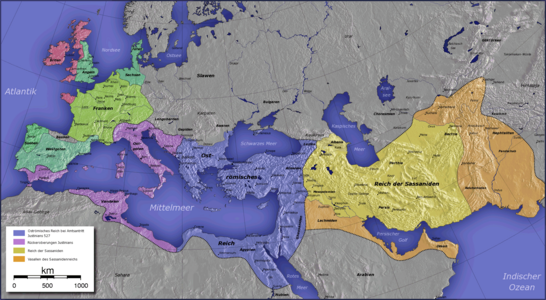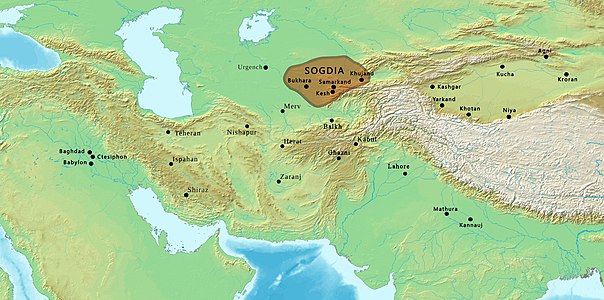318:
190:
241:
214:
36:
149:
78:
189:
284:
by 551 CE. While they were in China, they observed the intricate methods for raising silkworms and producing silk. This was a key development, as the Romans had previously thought silk was made in India. In 552 CE, the two monks sought out
Justinian I. In return for his generous but unknown promises,
213:
304:
are rather fragile and have to be constantly kept at an ideal temperature, lest they perish, they used their contacts in
Sogdiana to smuggle out silkworm eggs or very young larvae instead, which they hid within their bamboo canes.
240:
167:, importing silk to Europe became increasingly difficult and expensive. The Persians strictly controlled trade in their territory and would suspend trade in times of war. Consequently, the Roman Emperor
347:. The acquired silkworms allowed the Roman Empire to have a silk monopoly in Europe. The acquisition also broke the Chinese and Persian silk monopolies. The resulting monopoly was a foundation for the
309:
bushes, which are required for silkworms, were either given to the monks or already imported into the Roman Empire. All in all, it is estimated that the entire expedition lasted two years.
17:
159:
was first produced sometime during the third millennium BCE by the
Chinese. By the first century CE, there was a steady flow of silk into the Roman Empire. With the rise of the
455:
133:
50:
500:
526:
317:
606:
183:. The failure of these efforts led Justinian I to look elsewhere since demand for this luxury good was high, even within his inner circle.
544:
504:
454:
Walker, Alicia (2021). "Cross-cultural
Artistic Interaction in the Early Byzantine Period". In Freeman, Evan (ed.).
251:
195:
565AD. Roman Empire, blue and purple; Sassanid Empire in yellow. Sassanid vassals, in orange, encompassing the
601:
281:
277:
285:
the monks agreed to acquire silkworms from China. They most likely traveled a northern route along the
530:
591:
389:
164:
273:
355:, were almost always reserved for the elite in Byzantium, and their wearing was codified in
27:
6th-century event in which two monks smuggled silkworm eggs into the Roman Empire from China
586:
581:
8:
351:
for the next 650 years until its demise in 1204. Silk clothes, especially those dyed in
231:
596:
548:
364:
227:
204:
269:
175:, which at the time had become a major silk-producing centre: one to the north via
180:
160:
344:
328:
321:
426:
Clare, Israel (1906), Library of
Universal History: Mediaeval History pg. 1590
575:
356:
352:
348:
340:
290:
255:
122:
223:
196:
301:
294:
200:
168:
129:
125:
359:. Silk production in the region around Constantinople, particularly in
132:
into the Roman Empire, which led to the establishment of an indigenous
286:
247:
306:
219:
172:
137:
148:
336:
501:"Late Roman Silk: Smuggling and Espionage in the 6th Century CE"
360:
332:
176:
121:
In the mid-6th century CE, two monks, with the support of the
77:
226:
north of the
Sassanid states. Silk was also produced in the
156:
71:
Stealing and smuggle of silkworm eggs into the Roman Empire
327:
Shortly after the expedition there were silk factories in
363:
in northern Greece, has continued to the present (see:
18:
Smuggling of silkworm eggs into the
Byzantine Empire
268:Two unidentified monks (most likely members of the
573:
246:Silk production also occurred in these areas of
440:
438:
436:
434:
432:
384:
382:
380:
230:(east of Sogdiana) at this time, and in the
469:
467:
422:
420:
207:in the northeast (both silk-growing areas).
171:tried creating alternative trade routes to
494:
492:
490:
488:
76:
429:
377:
498:
464:
417:
316:
147:
35:
485:
14:
574:
453:
503:. Stanford University. Archived from
527:"The Smithsonian on Silk Production"
115:Establishment of Roman silk industry
29:
607:6th century in the Byzantine Empire
545:"History of Silk - The Silk Museum"
457:Smarthistory Guide to Byzantine Art
24:
25:
618:
239:
212:
188:
34:
555:
537:
252:Northern and Southern dynasties
199:to the south, and reaching the
128:, acquired and smuggled living
519:
476:
447:
412:Byzantium: The Early Centuries
404:
13:
1:
263:
234:, east of the Sassanid Empire
143:
91:Mid-6th century (552/563 CE)
45:appears to contradict itself
7:
278:Church of the East in India
179:, and one to the south via
10:
623:
563:Silk in the Medieval World
392:. University of Washington
370:
289:, taking them through the
312:
272:) who had been preaching
203:in the southeast and the
111:
103:
95:
87:
75:
561:Muthesius, Anna (2003),
43:This article or section
533:on September 27, 2009.
410:Norwich, John (1988),
365:Silk museums of Soufli
324:
153:
136:that long held a silk
320:
274:Christianity in India
151:
53:for more information.
602:6th century in China
232:Indian subcontinent
163:and the subsequent
134:Roman silk industry
72:
325:
165:Roman–Persian Wars
154:
70:
250:in 560AD, in the
228:Kingdom of Khotan
205:Kingdom of Khotan
119:
118:
68:
67:
16:(Redirected from
614:
566:
559:
553:
552:
547:. Archived from
541:
535:
534:
529:. Archived from
523:
517:
516:
514:
512:
496:
483:
480:
474:
471:
462:
461:
451:
445:
444:Norwich, pg. 266
442:
427:
424:
415:
408:
402:
401:
399:
397:
386:
270:Nestorian Church
243:
216:
192:
80:
73:
69:
63:
60:
54:
38:
37:
30:
21:
622:
621:
617:
616:
615:
613:
612:
611:
592:Silk production
572:
571:
570:
569:
560:
556:
551:on 1 July 2020.
543:
542:
538:
525:
524:
520:
510:
508:
507:on 26 June 2013
497:
486:
482:Clare, pg. 1587
481:
477:
473:Clare, pg. 1589
472:
465:
452:
448:
443:
430:
425:
418:
409:
405:
395:
393:
388:
387:
378:
373:
353:imperial purple
315:
266:
259:
244:
235:
217:
208:
193:
161:Sassanid Empire
146:
83:
64:
58:
55:
49:Please see the
48:
39:
28:
23:
22:
15:
12:
11:
5:
620:
610:
609:
604:
599:
594:
589:
584:
568:
567:
554:
536:
518:
499:Patrick Hunt.
484:
475:
463:
446:
428:
416:
403:
375:
374:
372:
369:
357:sumptuary laws
329:Constantinople
322:Byzantine silk
314:
311:
280:), made their
265:
262:
261:
260:
245:
238:
236:
218:
211:
209:
194:
187:
145:
142:
117:
116:
113:
109:
108:
105:
101:
100:
97:
93:
92:
89:
85:
84:
81:
66:
65:
42:
40:
33:
26:
9:
6:
4:
3:
2:
619:
608:
605:
603:
600:
598:
595:
593:
590:
588:
585:
583:
580:
579:
577:
564:
558:
550:
546:
540:
532:
528:
522:
506:
502:
495:
493:
491:
489:
479:
470:
468:
459:
458:
450:
441:
439:
437:
435:
433:
423:
421:
413:
407:
391:
385:
383:
381:
376:
368:
366:
362:
358:
354:
350:
349:Roman economy
346:
342:
338:
334:
330:
323:
319:
310:
308:
303:
298:
296:
292:
291:Transcaucasus
288:
283:
279:
275:
271:
257:
256:Six Dynasties
253:
249:
242:
237:
233:
229:
225:
222:, located in
221:
215:
210:
206:
202:
198:
191:
186:
185:
184:
182:
178:
174:
170:
166:
162:
158:
150:
141:
139:
135:
131:
127:
124:
123:Roman emperor
114:
110:
106:
102:
98:
94:
90:
86:
82:The Silk Road
79:
74:
62:
59:November 2022
52:
46:
41:
32:
31:
19:
562:
557:
549:the original
539:
531:the original
521:
509:. Retrieved
505:the original
478:
456:
449:
411:
406:
394:. Retrieved
326:
300:Since adult
299:
282:way to China
267:
224:Central Asia
197:Persian Gulf
155:
120:
104:Participants
99:Central Asia
56:
44:
587:Sericulture
582:Justinian I
295:Caspian Sea
201:Indus river
169:Justinian I
140:in Europe.
126:Justinian I
576:Categories
264:Expedition
144:Background
597:Smuggling
302:silkworms
287:Black Sea
248:East Asia
152:Silkworms
130:silkworms
107:Two monks
51:talk page
511:20 April
396:20 April
307:Mulberry
293:and the
220:Sogdiana
181:Ethiopia
173:Sogdiana
138:monopoly
96:Location
565:pg. 326
414:pg. 265
371:Sources
337:Antioch
112:Outcome
390:"Silk"
361:Thrace
345:Thebes
343:, and
333:Beirut
313:Impact
258:period
177:Crimea
513:2013
398:2013
341:Tyre
157:Silk
88:Date
367:).
254:or
578::
487:^
466:^
431:^
419:^
379:^
339:,
335:,
331:,
297:.
515:.
460:.
400:.
276:(
61:)
57:(
47:.
20:)
Text is available under the Creative Commons Attribution-ShareAlike License. Additional terms may apply.




